Page 211 of 424
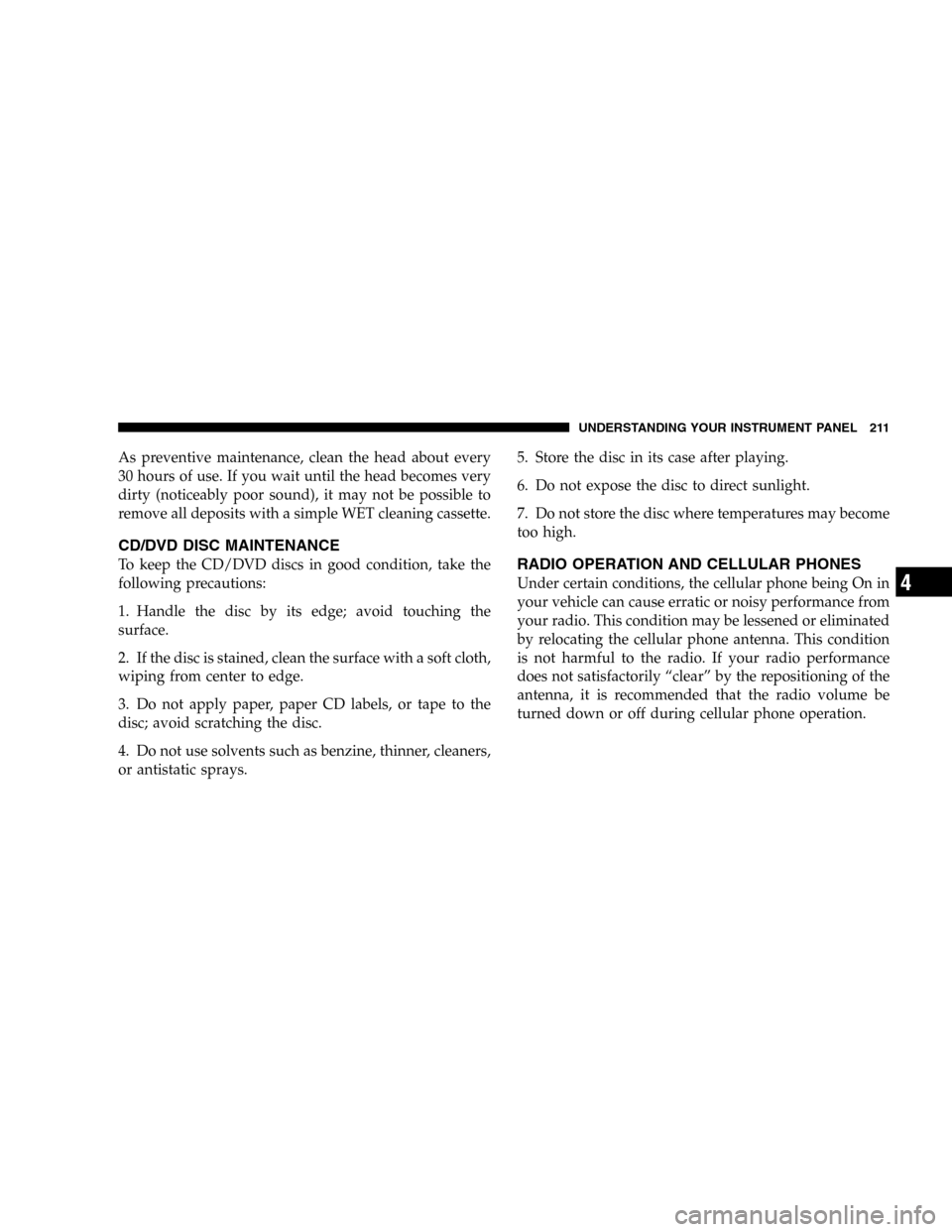
As preventive maintenance, clean the head about every
30 hours of use. If you wait until the head becomes very
dirty (noticeably poor sound), it may not be possible to
remove all deposits with a simple WET cleaning cassette.
CD/DVD DISC MAINTENANCE
To keep the CD/DVD discs in good condition, take the
following precautions:
1. Handle the disc by its edge; avoid touching the
surface.
2. If the disc is stained, clean the surface with a soft cloth,
wiping from center to edge.
3. Do not apply paper, paper CD labels, or tape to the
disc; avoid scratching the disc.
4. Do not use solvents such as benzine, thinner, cleaners,
or antistatic sprays.5. Store the disc in its case after playing.
6. Do not expose the disc to direct sunlight.
7. Do not store the disc where temperatures may become
too high.RADIO OPERATION AND CELLULAR PHONES
Under certain conditions, the cellular phone being On in
your vehicle can cause erratic or noisy performance from
your radio. This condition may be lessened or eliminated
by relocating the cellular phone antenna. This condition
is not harmful to the radio. If your radio performance
does not satisfactorily “clear” by the repositioning of the
antenna, it is recommended that the radio volume be
turned down or off during cellular phone operation.
UNDERSTANDING YOUR INSTRUMENT PANEL 211
4
Page 213 of 424
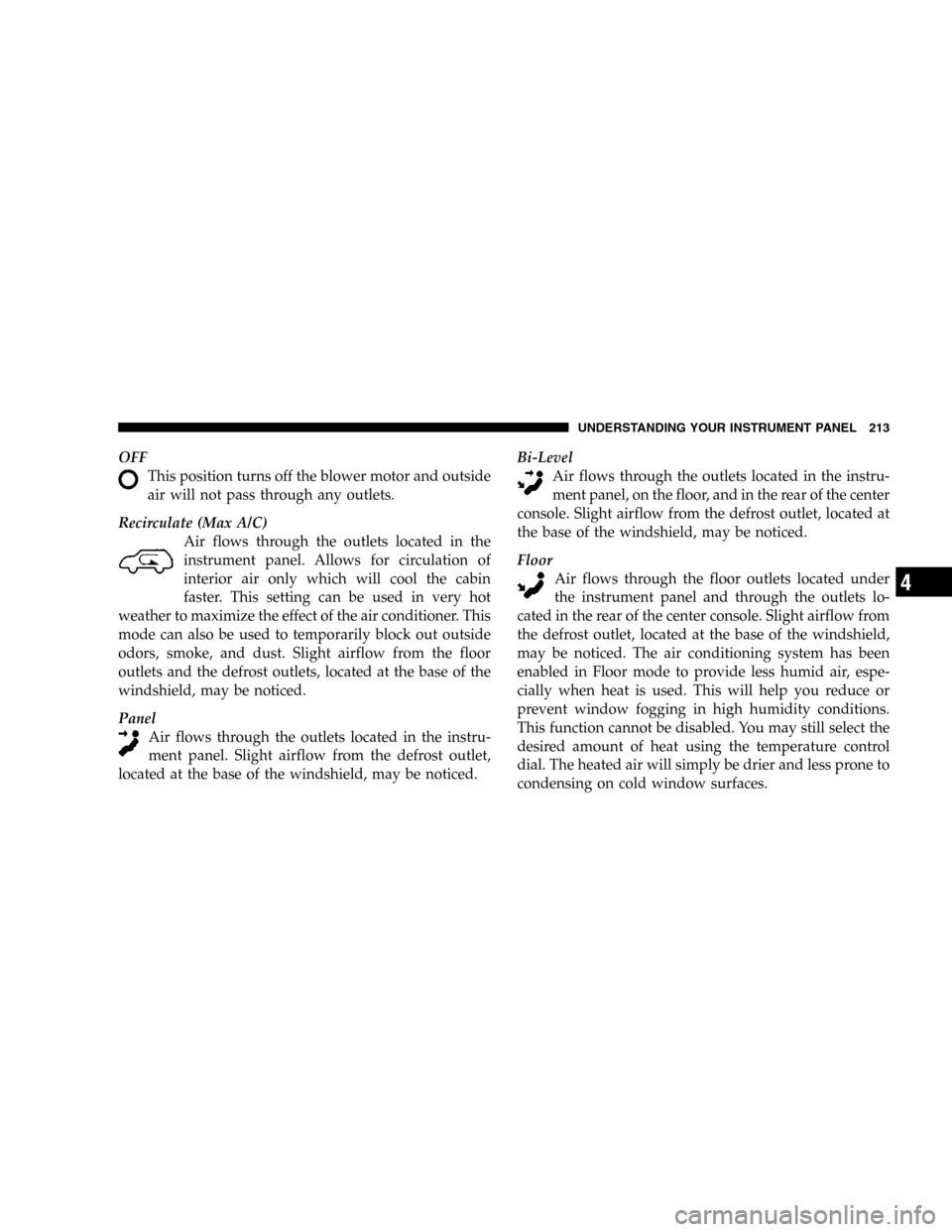
OFF
This position turns off the blower motor and outside
air will not pass through any outlets.
Recirculate (Max A/C)
Air flows through the outlets located in the
instrument panel. Allows for circulation of
interior air only which will cool the cabin
faster. This setting can be used in very hot
weather to maximize the effect of the air conditioner. This
mode can also be used to temporarily block out outside
odors, smoke, and dust. Slight airflow from the floor
outlets and the defrost outlets, located at the base of the
windshield, may be noticed.
Panel
Air flows through the outlets located in the instru-
ment panel. Slight airflow from the defrost outlet,
located at the base of the windshield, may be noticed.Bi-Level
Air flows through the outlets located in the instru-
ment panel, on the floor, and in the rear of the center
console. Slight airflow from the defrost outlet, located at
the base of the windshield, may be noticed.
Floor
Air flows through the floor outlets located under
the instrument panel and through the outlets lo-
cated in the rear of the center console. Slight airflow from
the defrost outlet, located at the base of the windshield,
may be noticed. The air conditioning system has been
enabled in Floor mode to provide less humid air, espe-
cially when heat is used. This will help you reduce or
prevent window fogging in high humidity conditions.
This function cannot be disabled. You may still select the
desired amount of heat using the temperature control
dial. The heated air will simply be drier and less prone to
condensing on cold window surfaces.
UNDERSTANDING YOUR INSTRUMENT PANEL 213
4
Page 220 of 424

STARTING PROCEDURES
Before starting your vehicle, adjust your seat, adjust both
inside and outside mirrors, and fasten your seat belts.
WARNING!
Do not leave children or animals inside parked
vehicles in hot weather. Interior heat build up may
cause serious injury or death.
Manual Transmission
Apply the parking brake, place the gearshift control lever
in N (Neutral) and depress the clutch pedal before
starting vehicle. This vehicle is equipped with a clutch
interlocking ignition system, which requires the clutch to
be fully depressed before starting the vehicle.4WD Models Only
In 4L mode, this vehicle will start regardless of whether
or not the clutch pedal is pressed to the floor. This feature
enhances off-road performance by allowing the vehicle to
start when in 4L without having to depress the clutch
pedal. The 4 LO MODE indicator light will illuminate
when the transfer case has been shifted into this mode.
Automatic Transmission
Start the engine with the selector lever in the N (Neutral)
or P (Park) position. Apply the brake before shifting to
any driving range.
220 STARTING AND OPERATING
Page 223 of 424
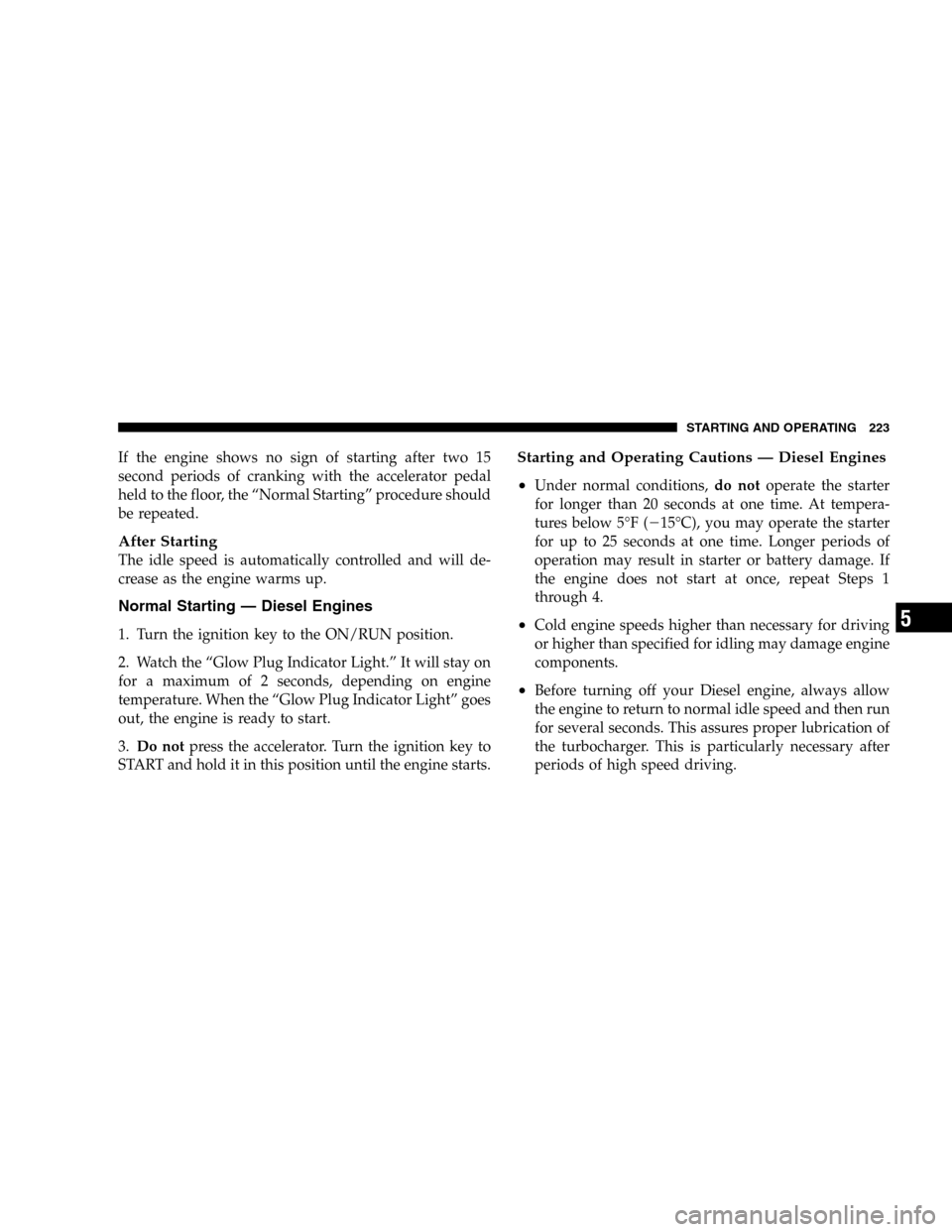
If the engine shows no sign of starting after two 15
second periods of cranking with the accelerator pedal
held to the floor, the “Normal Starting” procedure should
be repeated.
After Starting
The idle speed is automatically controlled and will de-
crease as the engine warms up.
Normal Starting — Diesel Engines
1. Turn the ignition key to the ON/RUN position.
2. Watch the “Glow Plug Indicator Light.” It will stay on
for a maximum of 2 seconds, depending on engine
temperature. When the “Glow Plug Indicator Light” goes
out, the engine is ready to start.
3.Do notpress the accelerator. Turn the ignition key to
START and hold it in this position until the engine starts.
Starting and Operating Cautions — Diesel Engines
•
Under normal conditions,do notoperate the starter
for longer than 20 seconds at one time. At tempera-
tures below 5°F (�15°C), you may operate the starter
for up to 25 seconds at one time. Longer periods of
operation may result in starter or battery damage. If
the engine does not start at once, repeat Steps 1
through 4.
•Cold engine speeds higher than necessary for driving
or higher than specified for idling may damage engine
components.
•Before turning off your Diesel engine, always allow
the engine to return to normal idle speed and then run
for several seconds. This assures proper lubrication of
the turbocharger. This is particularly necessary after
periods of high speed driving.
STARTING AND OPERATING 223
5
Page 225 of 424
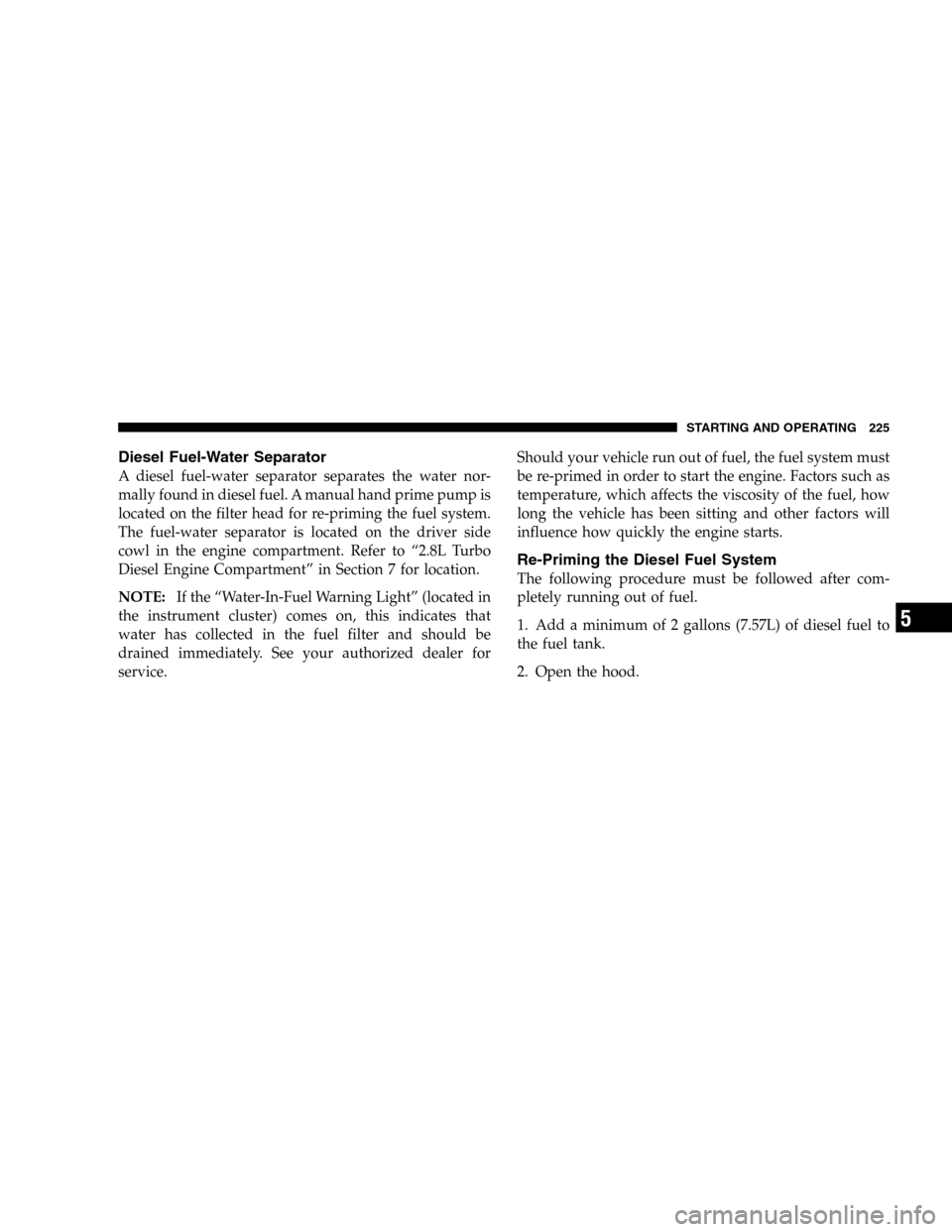
Diesel Fuel-Water Separator
A diesel fuel-water separator separates the water nor-
mally found in diesel fuel. A manual hand prime pump is
located on the filter head for re-priming the fuel system.
The fuel-water separator is located on the driver side
cowl in the engine compartment. Refer to “2.8L Turbo
Diesel Engine Compartment” in Section 7 for location.
NOTE:If the “Water-In-Fuel Warning Light” (located in
the instrument cluster) comes on, this indicates that
water has collected in the fuel filter and should be
drained immediately. See your authorized dealer for
service.Should your vehicle run out of fuel, the fuel system must
be re-primed in order to start the engine. Factors such as
temperature, which affects the viscosity of the fuel, how
long the vehicle has been sitting and other factors will
influence how quickly the engine starts.
Re-Priming the Diesel Fuel System
The following procedure must be followed after com-
pletely running out of fuel.
1. Add a minimum of 2 gallons (7.57L) of diesel fuel to
the fuel tank.
2. Open the hood.
STARTING AND OPERATING 225
5
Page 227 of 424
WARNING!
Remember to disconnect the cord before driving.
Damage to the 110-115 volt AC electrical cord could
cause electrocution.
Use the heater when temperatures below 0°F (-18°C) are
expected to last for several days.
TRANSMISSION SHIFTING
6-Speed Manual Transmission
Follow the shift pattern on the gearshift knob.
NOTE:The backup lights will come on when your
vehicle is in R (Reverse) gear and the ignition is in the ON
position.Manual Shift Controls
STARTING AND OPERATING 227
5
Page 233 of 424
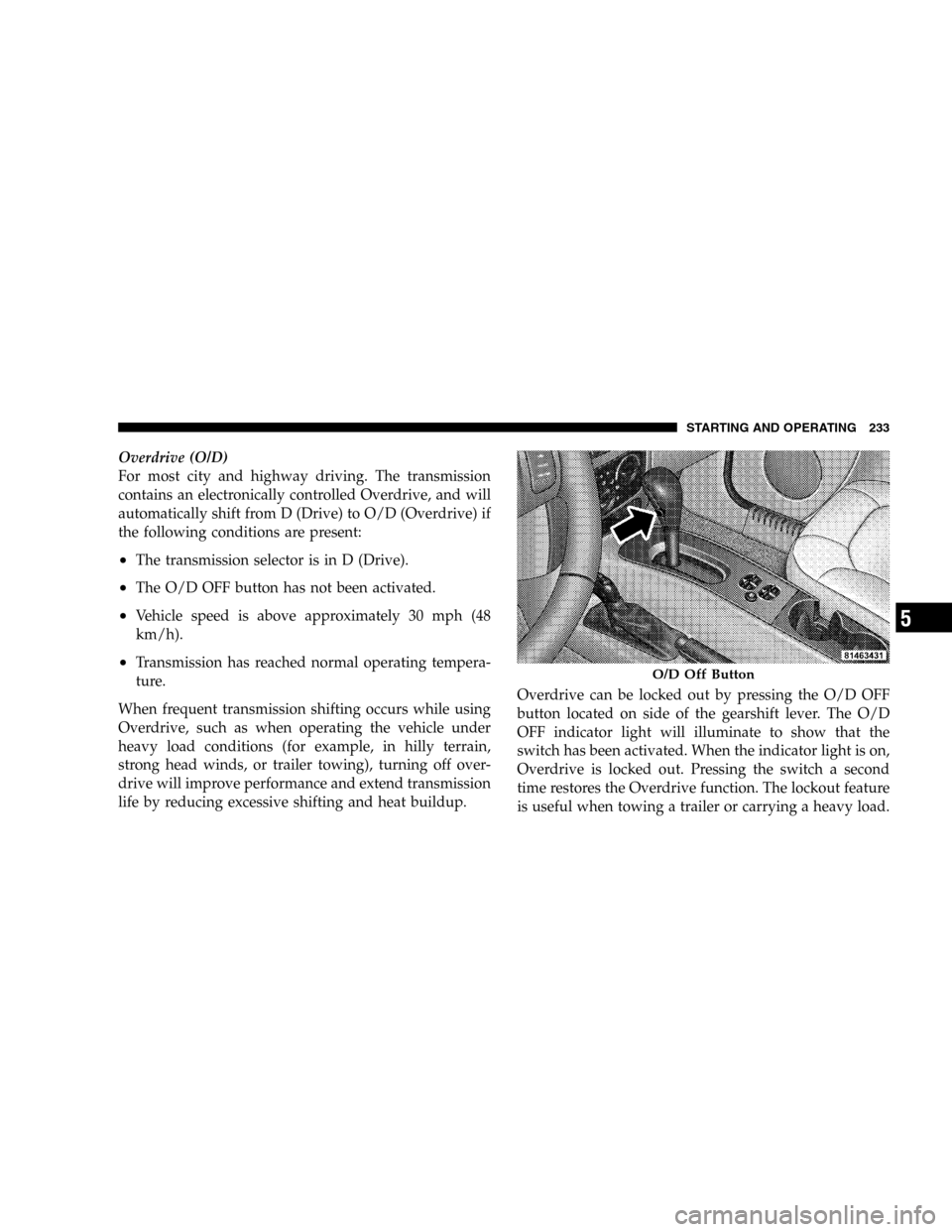
Overdrive (O/D)
For most city and highway driving. The transmission
contains an electronically controlled Overdrive, and will
automatically shift from D (Drive) to O/D (Overdrive) if
the following conditions are present:
•The transmission selector is in D (Drive).
•The O/D OFF button has not been activated.
•Vehicle speed is above approximately 30 mph (48
km/h).
•Transmission has reached normal operating tempera-
ture.
When frequent transmission shifting occurs while using
Overdrive, such as when operating the vehicle under
heavy load conditions (for example, in hilly terrain,
strong head winds, or trailer towing), turning off over-
drive will improve performance and extend transmission
life by reducing excessive shifting and heat buildup.Overdrive can be locked out by pressing the O/D OFF
button located on side of the gearshift lever. The O/D
OFF indicator light will illuminate to show that the
switch has been activated. When the indicator light is on,
Overdrive is locked out. Pressing the switch a second
time restores the Overdrive function. The lockout feature
is useful when towing a trailer or carrying a heavy load.O/D Off Button
STARTING AND OPERATING 233
5
Page 235 of 424

Over Temperature Mode
The transmission electronics constantly monitor the
transmission oil temperature. If the transmission gets too
hot, the transmission will change the way it shifts to help
control the condition. This may result in a slightly
different feeling or response during normal operation in
D (Drive) position. If the transmission becomes hot
enough the TRANS TEMP warning light in the instru-
ment cluster will come on. After the transmission cools
down, it will return to normal operation.
Torque Converter Clutch
A feature designed to improve fuel economy has been
added to the automatic transmission of this vehicle. A
clutch within the torque converter engages automatically
at calibrated speeds. This may result in a slightly differ-
ent feeling or response during normal operation in high
gear. When the vehicle speed drops or during accelera-
tion, the clutch automatically and smoothly disengages.NOTE:
•The torque converter clutch (TCC) will not engage
until the transmission fluid and engine coolant are
warm (usually after 1–3 miles (1.6–4.8 km) of driving)
and the vehicle speed is above approximately 30 mph
(48 km/h). To understand the difference in operation,
drive the vehicle so that TCC engagement conditions
are correct, and then press and release the “O/D OFF”
button once to disengage the TCC. Wait a few seconds,
and then press and release the “O/D OFF” button
again to engage the TCC. You will notice that the
engine runs at a higher RPM when driving at vehicle
speeds above approximately 30 mph (48 km/h) with
the TCC not engaged. This is a normal condition.
•If the vehicle has not been driven for several days, the
first few seconds of operation after shifting the trans-
mission into gear may seem sluggish. This is due to the
transmission fluid partially draining from the torque
converter into the transmission. This is considered a
STARTING AND OPERATING 235
5